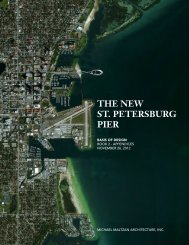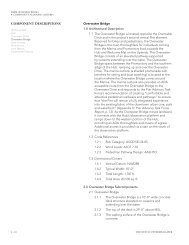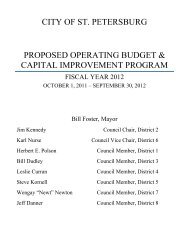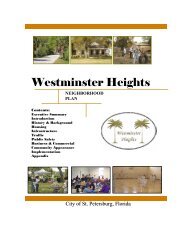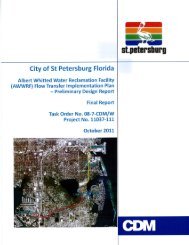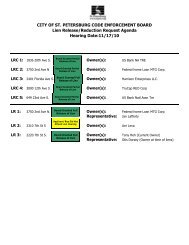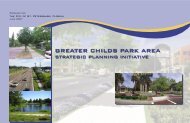Book 1 - City of St. Petersburg
Book 1 - City of St. Petersburg
Book 1 - City of St. Petersburg
You also want an ePaper? Increase the reach of your titles
YUMPU automatically turns print PDFs into web optimized ePapers that Google loves.
BASIS OF DESIGN BOOK 1<br />
3 GENERAL PLANNING CRITERIA<br />
ENGINEERING CRITERIA<br />
(continued)<br />
Foundation Selection and Design<br />
The piles that will support the new Pier must be engineered to<br />
withstand not only the dead and live loads <strong>of</strong> the Pier, but also<br />
the loads from hurricane winds, breaking waves, and lateral<br />
currents. There are several pile type options that can be used to<br />
form the foundation <strong>of</strong> the Pier. Although not recommended,<br />
reuse <strong>of</strong> existing piles is a possibility after a thorough inspection<br />
<strong>of</strong> their current condition is completed. Driving new piles is<br />
another option as well. Additional information related to the<br />
existing piles and other engineering concerns that was discussed<br />
in a meeting concerning general site conditions can be found in<br />
Appendix D: General Site Conditions Meeting Minutes, June 27,<br />
2012 (McLaren Engineering Group).<br />
New piles can be made <strong>of</strong> steel, timber, or prestressed concrete.<br />
Each material option has its advantages and an analysis weighing<br />
function with cost is necessary to determine the optimal material<br />
for final design. A preliminary analysis <strong>of</strong> foundation types<br />
follows:<br />
Existing Piles<br />
Reusing the existing piles is not recommended. The existing<br />
piles are approximately 90 years old and, in many cases, have<br />
been condemned, driving the decision to demolish the existing<br />
Pier. The location and orientation <strong>of</strong> the existing piles in relation<br />
to the intersecting new Pier would also be a limitation. However,<br />
the existing caissons under the Inverted Pyramid building have<br />
potential for reuse to support the <strong>of</strong>fshore components <strong>of</strong> the<br />
new Pier.<br />
New <strong>St</strong>eel Piles<br />
<strong>St</strong>eel piles are generally either pipe piles or rolled steel<br />
H-section piles. Using steel as a pile material has the advantage<br />
<strong>of</strong> being easy to handle with respect to cut<strong>of</strong>f and extension to<br />
the desired length during installation. They have a high loadcarrying<br />
capacity and can penetrate hard layers such as dense<br />
gravel and s<strong>of</strong>t rock. However, they are relatively costly and are<br />
subject to corrosion. Due to the corrosive nature <strong>of</strong> a coastal<br />
environment, epoxy coatings must be applied to resist the<br />
effects <strong>of</strong> salt water.<br />
Prestressed Concrete Piles<br />
Concrete piles are reinforced to resist the bending moment<br />
developed during pickup and transportation, the vertical load<br />
and the bending moment caused by a lateral load. They can be<br />
subject to hard driving, can be easily combined with a concrete<br />
superstructure and are corrosion resistant. However, they can<br />
be difficult to transport in some locations and achieving proper<br />
cut<strong>of</strong>f during installation may be difficult. Despite this, concrete<br />
piles may be the best option as concrete is resilient in coastal<br />
environments and is not affected by marine borers.<br />
3 - 86<br />
THE NEW ST. PETERSBURG PIER




